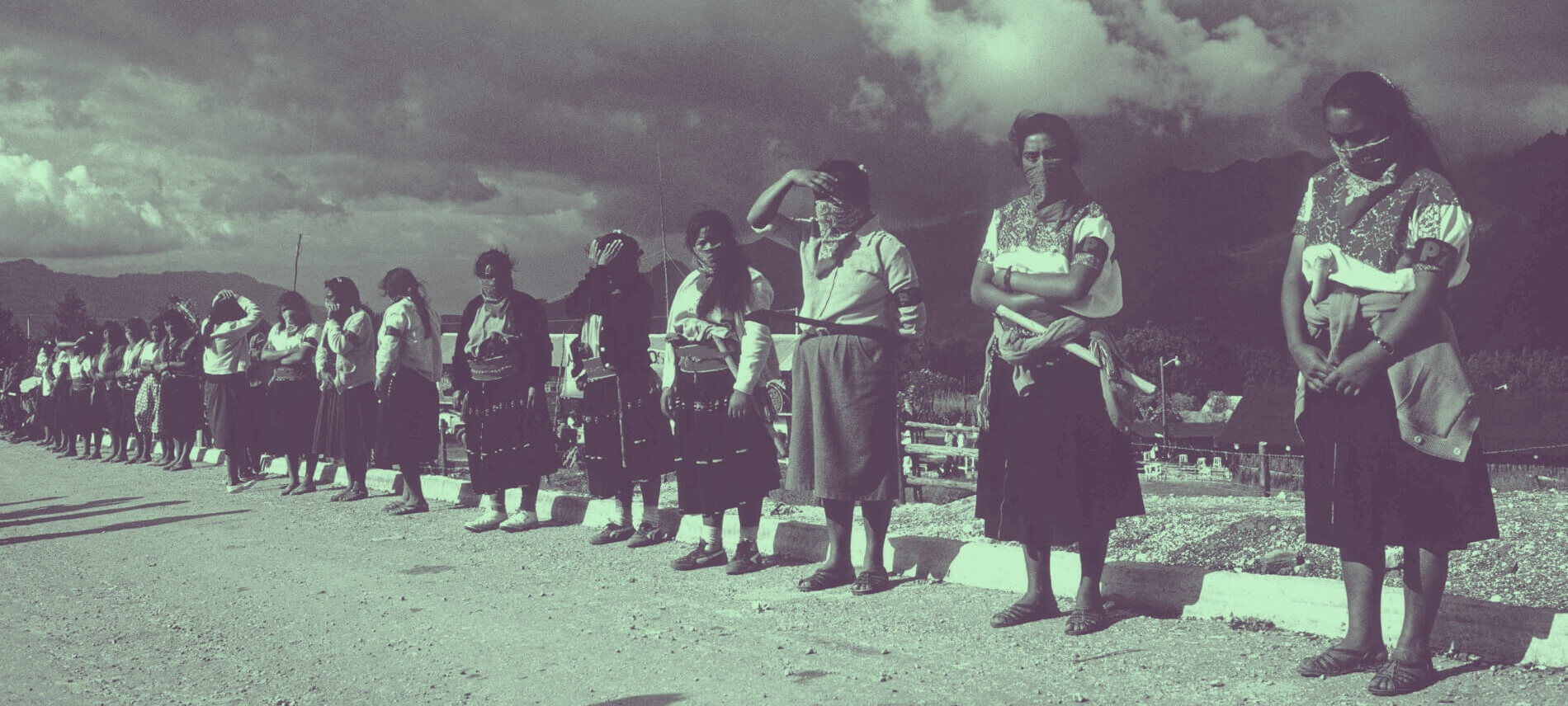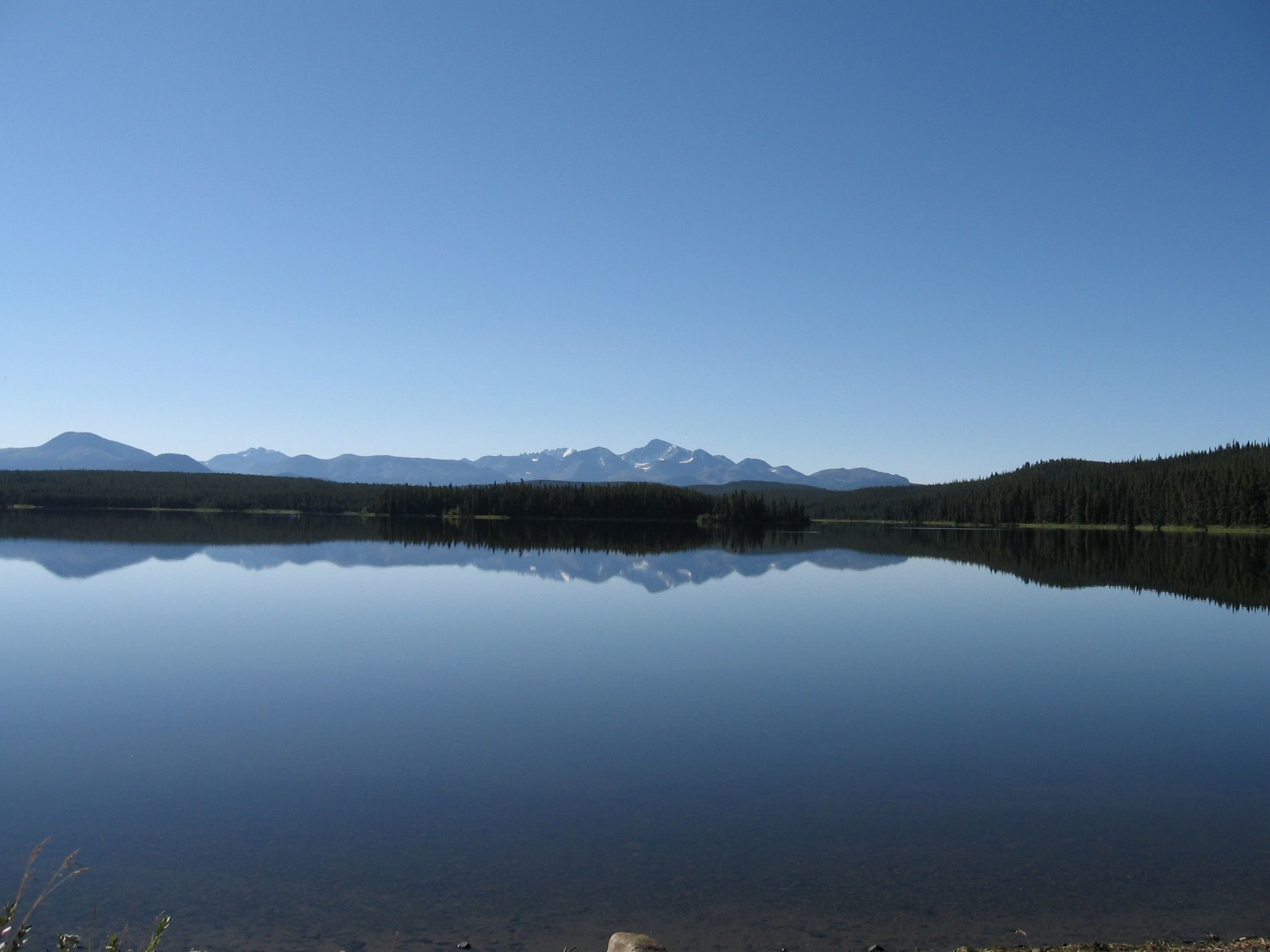
The Indigenous Rights Report is a weekly crash course on everything in the indigenous world.
Make this podcast happen! Support us on Patreon!

In this week’s Indigenous Rights Report:
- The treatment of migrants by US border officials becomes a “ticking time bomb”;
- Navajo scientist calls new uranium rush a threat to tribal lands;
- Members of the Tŝilhqot’in nation block access to the New Prosperity mine;
- India’s top court sides with Indigenous peoples over illegal mining fallout;
- A leading West Papuan independence organization claims to have unified three rebel armies;
- Activists launch rescue of “Chocholteco”, an indigenous language in danger of extinction;
- Thousands of goldminers invade Yanomami territory;
- Indigenous communities head towards energy self-sufficiency in Guatemala;
- Climate change turns a community into a village of ‘beggars’;
- 250 Indigenous communities could be displaced by the “Mayan Train” project;
- Indigenous leaders sign historic national park document;
- A state of emergency is declared for the Cherokee language;
- Indigenous communities gain legal rights to harvest coffee sustainably;
- Growing threats to Colombia’s isolated Indigenous peoples
- OAS and Amazon agree to empower Indigenous youth in the Inter-American System;
- A new app teaches the Indigenous history of Washington, D.C.
The treatment of migrants by US border officials has become a “ticking time bomb“. According the US government’s own investigation into the humanitarian crisis, there is “serious overcrowding and prolonged detention of unaccompanied alien children, families, and single adults that require immediate attention.” Government investigators published graphic photos of extreme overcrowding at various migrant facilities where children had no access to showers and had to sleep on concrete.
During her congressional oversight visit, Rep. Alexandria Ocasio-Cortez (D-New York) observed that many of the detained persons are of Indigenous descent. “Some I met were budding trilingual (speak K’iche’, Spanish & learning English),” she stated.
The report concluded that “The current situation on the Southern Border represents an acute and worsening crisis. Our immigration system is not equipped to accommodate a migration pattern like the one we are experiencing now.”

Overcrowding documented by the Department of Homeland Security’s Inspector General.
The Trump administration issued a directive to locate uranium and expedite its extraction for the purposes of the country’s economic and national security. In response to the announcement, tribal members, environmentalists and lawmakers told a House panel that adding uranium to the list of “critical minerals” puts tribal lands and national parks at risk.
Tommy Rock, an environmental scientist who lives on the Navajo Nation, said that this measure could lead to a “rush to make public lands open for business” that will lead to more pollution. He said residents of the Navajo Nation are still grappling with illnesses he believes were caused by contaminated runoff from uranium mines. Amber Reimondo, energy program director for the Grand Canyon Trust, highlighted the public and environmental health risks that come with mining, and that especially “uranium pollution remains a threat for many generations into the future.”
She was one of several witnesses testifying in support of a bill [H.R.3405] by Rep. Raul Grijalva, D-Tucson, that would order the Interior Department to remove uranium from the list of critical minerals – permanently.
A Dayak community in Indonesian Borneo has won the United Nations Development Programme’s (UNDP) Equator Prize in recognition of the community’s efforts to sustainably manage their community forest in the face of large-scale deforestation and cultural loss across Borneo. Over the past half century, more than 30% of Borneo’s rainforests have been logged for timber; strip-mined for gold, coal, and sand; and drained, cleared, and burned for industrial plantations.
Apay Janggut, head of the Sungai Utik community longhouse, explained that the Dayak Iban of Sungai Utik have managed to preserve more than 6,000 hectares of old-growth in their 9,450-hectare customary forest by observing their traditional customs. Among other things, the community is now writing a book about the uses of plants in their customary forest, to help preserve their knowledge for future generations and to help the government understand that the forest is valuable for reasons other than timber, mining, and palm oil.
Members of the Tŝilhqot’in nation blocked access to Taseko’s controversial New Prosperity mine site to protect Teẑtan Biny (Fish Lake). A roadblock was set up some 80 kilometres from the site southwest of Williams Lake. When Taseko crews arrived, members of the Tsilhqot’in Nation told them they would have to turn back. The company is now seeking a court injunction.
The New Prosperity mine has been rejected twice by the federal government on environmental grounds. The Tsilhqot’in say that the area is a sacred landscape that serves as a resting place for ancestors, a site for ceremonial activities and a space of cultural significance for the Tsilhqot’in identity.
Brian Battison, vice-president of corporate affairs for Taseko Mines Ltd., said the project would mean the creation of many new jobs in British Colombia. Joe Alphonse, chief of the Tl’etinqox and the tribal chair of the Tsilhqot’in National Government (TNG), explained that First Nations want to be involved in these projects, but they have to be properly consulted, and the projects pursued “in areas deemed to be acceptable.”

Teztan Biny (Fish Lake) Photo: Loretta Williams/The Dominion
India’s Supreme Court ruled that indigenous people in the northeastern Meghalaya state must be protected from illegal mining and the pollution it causes. This ruling provides a “historic” victory to tribal groups fighting for better rights over land and natural resources.
The heavily forested state of Meghalaya has substantial reserves of minerals, such as coal, limestone and uranium. At its peak, the state produced coal worth $4 billion a year, or about a tenth of India’s total production. But illegal mining “exacerbated socio-economic inequality, destroyed the environment, and devastated tribal communities,” as Colin Gonsalves, a lawyer for the indigenous groups that filed the legal challenge, said. Despite a ban of illegal mining in 2014 by India’s environmental court, the National Green Tribunal, many mines continue to operate.
India’s Constitution protects the right of indigenous people over their land and resources in four northeastern states including Meghalaya, but in reality government authorities control the land, and communities seldom benefit. “The court’s ruling is significant, as it upholds the communities’ rights and strengthens their fight against illegal mining, but their struggle to control their land and resources is far from over,” Gonsalves said.
Hundreds of Waorani mobilized in the Amazonian city of Puyo to defend their historic court ruling protecting their 500,000-acre homeland from oil drilling in the face of an appeal by the Ecuadorian government. The only government ministry to appeal the precedent-setting indigenous rights verdict was Ecuador’s Ministry of Environment, the very institution charged with environmental protection from the impacts of activities such as oil operations.
The April 26th court ruling by the three-judge panel of the Pastaza Provincial Court immediately voided the consultation process with the Waorani undertaken by the Ecuadorian government in 2012, indefinitely suspending the auctioning of their lands to oil companies. The Waorani victory, if upheld, would set an important precedent towards nullifying the prior consultation process undertaken by the government with seven indigenous nations and subsequently halting the auctioning off of more than 7 million acres in the Ecuadorian Amazon.
The Waorani’s global digital campaign to warn the Ecuadorian government that “Waorani territory is not for sale” has built a global movement of solidarity with the struggle, garnering more than 165,102 signatures.

Photo: Amazon Frontlines
A leading West Papuan independence organization, United Liberation Movement for West Papua (ULMWP), claims to have unified three rebel armies under its control, led by exiled leader Benny Wenda, who says they are now “ready to take over our country”. However, in a counter-statement, OPM leader, Jeffrey Bomanak, said the OPM and the TPNPB “reject and deny the claims made in the political statement on the alleged military merger”.
West Papua, which shares an island with Papua New Guinea, has been under Indonesian control since 1969. It is in the grip of a long-running independence conflict that has led to the death of more than 500,000 West Papuans.
Language activists are rescuing “Chocholteco”, an indigenous language in Mexico that is in danger of extinction. After just six months of promoting the culture, courses are now being taught to increase the number of speakers. Currently, there are only 60 people who speak this mother tongue across the 18 communities that make up the Chocholteca region in the district of Coixtlahuaca and Teposcolula (in Oaxaca, Mexico).
The loss of the language has been going on for several decades; people in this region used to speak Mixteco, Chocholteco, Nahuatl, but with the arrival of the Spaniards, they were forced to speak Latin and Castilian.
Thousands of goldminers are invading Yanomami territory in northern Brazil, spreading malaria and polluting rivers with mercury. Local indigenous leaders say the miners, emboldened by President Bolsonaro’s support for land invaders,are building settlements and airstrips and carrying out constant attacks on indigenous people. Some mining camps are just a few miles from uncontacted Yanomami. 20% of the Yanomami population in Brazil died from diseases brought in by goldminers during a previous gold rush in the late 1980s and early 90s.
The 35,000 Yanomami straddle both sides of the Brazil-Venezuela border. Yanomami land in Brazil was finally demarcated as the ‘Yanomami Park’ in 1992. The Yanomami territories in Brazil and Venezuela together form the largest forested indigenous territory in the world.
Indigenous communities in the mountains of northwest Guatemala are heading toward energy self-sufficiency, despite the fact that the government has never provided them with electricity. With the help of financial cooperation from organizations in Spain and Norway, and support from the environmental group MadreSelva, the first mini-hydroelectric plant has begun to operate on the Putul River. Community projects have been implemented in four indigenous villages.
Given the success of the first community hydropower plant, other villages have also decided to generate their own electric power. A similar plan is under way to build mini-dams in eight other indigenous villages in the neighboring region of Los Copones. They intend to share their electricity with 11 communities in the surrounding area, in a project for which the German development aid agency has contributed 1.25 million dollars.
Jessica Vega Ortega, co-chair of Global Indigenous Youth Caucus in Mexico, raised the issues of Indigenous peoples with the UN Secretary-General António Guterres in an open discussion at the Abu Dhabi Climate Meeting. Ortega said climate change has turned her Mixtec community into a village of beggars .
The life of around two thousand people in her mountainous village was turned upside down when the only river in the village dried up almost five years ago. The death of the river put an end to farming, the only livelihood of the villagers. “Not only livelihood, it was an end of the community’s cultural life as well,” she said. “We want concrete action from the UN and world governments to protect the livelihood and traditional life of indigenous people [from the negative impacts of climate change].”
The Abu Dhabi Climate Meeting was hosted by the UAE as a prelude to the UN Climate Action Summit 2019, set to take place from September 21 to 23 in New York.
Mexico’s National Fund for Tourism Promotion (Fonatur) recently announced that it plans to “reorganize” 250 communities to make way for the controversial “Mayan Train” project. Once completed, the so-called “Mayan Train” would transport tourists from the beach resorts of Cancún and the Riviera Maya on the Caribbean coast to inland archaeological sites such as the pyramids of Palenque.
Local organizations and Indigenous peoples have strongly rejected the project, arguing that a consultation should take place following international and national standards on the rights of Indigenous peoples and their autonomy.
“The Mayan Train has nothing to do with the indigenous Maya, nor does mass tourism benefit the Maya population. We don’t want to be a new Cancún or Riviera Maya, where international hotel chains, travel companies and restaurant chains are the only beneficiaries,” the communities wrote to Mexican President Lopez Obrador.
A historic memorandum of understanding was signed by the Province of British Columbia, the Canadian federal government and the Okanagan Nation to establish a national park reserve in the South Okanagan. Tthe document marks the first time First Nations are full partners in negotiating a final legal agreement outside of the territories, and is the first federal agreement to feature the Syilx language. Minister of Environment and Climate Change, Catherine McKenna, said the agreement is “an example for the world,” on working with Indigenous communities. “We need to be working with Indigenous peoples if we’re going to tackle some of the biggest challenges we face whether it’s climate change or biodiversity loss,” McKenna said.
The memorandum outlines the working boundary of the proposed park, which would span 273 square kilometers. The document also confirms there will be no expropriation of private land outside of a willing-seller, willing-buyer basis and includes interim protection of provincial lands until a national park reserve is established. McKenna said an establishment agreement for the proposed park could come forward in one or two years.
The Cherokee language is officially in a state of emergency according to the three federally recognized Cherokee tribes. Officials from Cherokee Nation, Keetoowah Band and the Eastern Band came together as the Tri-Council to declare their language is in a state of emergency. They also passed a resolution to work together to revitalize it.
There are only about 2,000 fluent Cherokee speakers in the three federally recognized tribes. The resolution states that number is diminishing faster than new speakers are developing.
Indigenous coffee producers in Bengkulu, a province on Sumatra island in Indonesia, gained legal rights to harvest coffee sustainably on their traditional lands. The achievement was the result of a long process supported by AKAR Foundation in Bengkulu and Safir Law Firm in Jakarta, with funding support from RRI. Starting in 2010, AKAR Foundation helped local and indigenous communities secure rights under the social forestry program implemented by Indonesia’s Ministry of Environment and Forestry (MoEF). Social forestry is meant to expand the forest area under community management by providing usage rights in state forests and recognizing community ownership rights in customary forests.
The producers are not only selling their coffee under a new brand, “AKAR Coffee,” but they are also telling the story of a forest product that is sustainably managed by their communities. By buying this product, consumers not only support the preservation of forests, but also directly contribute to the prosperity of the communities who manage them.
The Yurí and the Passé are two Indigenous tribes that live in “voluntary isolation” in the Colombian Amazon–but that may soon change. In addition to the activities of mafia groups and illegal gold mining that is contaminating local rivers with mercury, evangelists are attempting to make contact with the isolated tribes.
This is not a new issue. For more than 18 years, the intermittent presence of illegal miners has been reported in the area. The fight to defend the indigenous territory continues unrelentingly. Suárez, of the Murui, and other indigenous Amazon leaders claim they are being killed for defending their forest and seeking an end to these criminal structures. While the authorities decide what action to take in order to stop the harm to the forest and the people living there, the communities are looking for a way to survive.
The Organization of American States (OAS) and the Amazon Conservation Team (ACT) will collaborate to train indigenous youth in the Inter-American System. The initiative will begin with young indigenous people from Colombia, Suriname, and Brazil, but it can be extended to indigenous communities in other countries. The purpose of this agreement is to train young people from the indigenous communities of the Americas to have a better understanding of the functioning of the OAS, the Inter-American instruments, and fundamentally, the rights of indigenous peoples.
The initiative will be implemented through the Department of Social Inclusion of the OAS, whose director, Betilde Muñoz-Pogossian, explained that the inequalities faced by indigenous youth can be reversed with actions aimed at generating opportunities and empowering them to fully exercise their rights. The agreement is made within the framework of the implementation of the 2017-2022 Action Plan for the implementation of the American Declaration on the Human Rights of Indigenous Peoples.
A new app called the “Guide to Indigenous DC” is re-framing the colonial narrative and the space that is Washington, D.C. Elizabeth Rule, Chickasaw, assistant director of the AT&T Center for Indigenous Politics and Policy at the George Washington University, designed the app along with scholars, local community members and historians, to serve the community.
Rule hopes tribal members, tribal leaders, delegates, Native youth, non-Natives, tourists and educational programs use the app so they can understand that Washington was and still is an Indigenous homelands. Those interested can take a walking tour (or virtual tour) of the 17 sites across Washington where significant moments in Indigenous history took place, (such as the takeover of the Bureau of Indian Affairs, the Indigenous Peoples March, or Native Nations March). The app is free to download on iPhones and the Android version is being worked on.
This is the Indigenous Rights Report.

Indigenous Peoples are putting their bodies on the line and it's our responsibility to make sure you know why. That takes time, expertise and resources - and we're up against a constant tide of misinformation and distorted coverage. By supporting IC you're empowering the kind of journalism we need, at the moment we need it most.